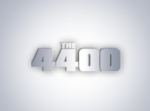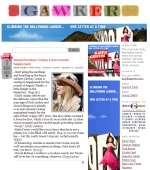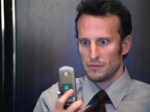So we finally got around to reading today's MediaPost newsletter and, upon opening it, were instantly attracted to an ad for alloy media + marketing which is promoting its 2005 College Explorer Youth Study. The ad, with the ubiquitous, exposed hottie-belly, is accompanied by the headline, "It's not what you think. It's what we know." The ad then animates to a frame promoting the study. This ad does three things brilliantly. It grabs attention. It debunks stereotypes. And it promotes a study that, one assumes, paints a realistic picture of the college market rather than the standard, Spring Break, thong-wearing, sex-crazed image we're all so fond of writing about. Of course the full image on the study order page sort of brings it all back home.
Knowing this site's audience, Alloy should really be advertising that study here.
To promote the season one DVD release of the HBO series, Six Feet Under, Charlotte agency BOONE/OAKLEY created a bus wrap which, in July, transformed transit buses into the green hearse the character Claire drive on the show. San Francisco and Los Angeles transit authorities rejected the ad for public transit claiming it could, somehow, hurt ridership. The ad was allowed, however, on private, no passenger buses. New York and Chicago accepted the ad.
TAG Body spray is getting the promotional online game treatment with Hide the Hotties and House Call. Hide the Hotties provides four increasingly difficult game levels in which you have to hide the hotties hanging in your pad before their Dad shows up at the door and kicks the crap out of you. Apparently, if you type the T, A, and G keys, that unlocks a bikini version of the game. This didn't work for us. House Call, which really should have been called Booty Call, lets the gamer sneak through the house to hook up with the hottie of the house.
The first one is amusing. The second one just doesn't work that well. Of course, that could simply be because we suck at online gaming and have an ADD-style attention span.
In a move that clearly cements the notion everyone is at the beck and call of the almighty advertising dollar, the city of Chicago, to eliminate a tax hike to offset a $94.1 million budget gap, is offering up several city assets upon which marketers can place their message. From the Chicago Skyway to the airports to libraries to water filtration plant to police and fire stations to bridges and more, everything seems to be for sale. It seems the city of Chicago could become one gigantic Times Square.
Today, we can't seem to get away from the topic of product placement. We received a link from Terry Heaton of Donata Communications who, last night, saw an episode of the USA alien abduction show, The 4400, in which Budweiser had a blatant placement Heaton thought went over the edge of credibility.
On his blog, he describes the scene, writing, "Following the funeral of one of their Korean War buddies, a group of guys head to a local pub to lift a few and remember the fellow. A story is told where one of the guys 'returned with three cases of Budweiser,' whereupon one of the guys lifts a can. The camera takes a tight shot. The guy says, 'Look at this can. It's just like it was back then.' Cut to a wide shot that shows the table is full of Budweiser cans."
While Heaton is one man, others certainly reacted as he did. "The writers of this show must have had a fit over writing this. Here's an entire scene in a drama that was created to sell Budweiser beer. Frankly, it ruined the show for me. An essential part of good drama is to draw the viewer into the story. That'll never happen again for me with this program."
If product placement generates this sort of reaction, it's not the sort of marketing tactic that'll stick around for long.
In a page-takeover sponsorship, Bravo is promoting its new six-episode, one-hour, unscripted Kathy Griffin show on Gawker and Defamer with several standard ad units along with a controversial date header logo which several bloggers dislike. The move is another in a the long list of line-blurring marketing stunts geared to attract waning eyeballs sick of advertising overload. It's the kid calling "wolf" though. The more advertising pervades media, the more it is ignored in an endless cycle sure to, someday, completely obliterate the usefulness of advertising itself.
Our online sleuth hates the sponsorship and tells us, "I don't mind exclusive sponsorships and advertisers, however, look how haphazardly they just put Kathy Griffin logos over Gawker's and Defamer's date placers. It just looks like a cut and paste. Doesn't look like it belongs there. Not to mention to me, those spots are off limits, that's the sacred space of of the editors"
While Gawker sites have had similar sponsorships, with Sony, Audi, Bridgestone and Cheap Tickets, before, what do those of you working in advertising think about this apparent erasure of the line? Is there a line? Was there ever a line? Should there be a line at all? Is advertising headed down a path of destruction or is this smart marketing? Give us your comments.
As we previously eluded to, Ask Jeeves, today, has made its official announcement it has launched a new sponsored listings program similar to Google's AdWords. The offering, an auction-based system called Sponsored Listings, is replacing the company's older Premier Listings product. Sponsored Listings will appear above Google AdWords which also appear on the site. The product is available now to existing Ask Jeeves Advertisers and will be available to new advertisers August 15.
This is funny. A Motorola spot promotes its Moto E815 video phone with a humorous stripping wife/conference room co-worker scenario. The spot captures what we all know to be true about video. In the hands of humans, the first thing we'll use it for is porn.
Other spots featured in this week's Ad Age TV Spots of the Week include a Hershey Kit Kay bar ad with American Idol's Carrie Underwood; a hopped up football themed ad for athletic clothing maker Under Armor; another one of those Diet Coke bubble ads; a spot from the previously featured Milwaukee's Best campaign; another goofy Dymo spot; one of those Microsoft Windows XP commercials that seem to think we will all turn into our own personal version of a super hero just by using Windows XP and a Wal-mart back to school commercial.
Thankfully, either TV Guide ended its contract or Ad Age, wisely, saw the irony in preceding a commercial with a commercial and, thankfully, ended the mind boggling, aggravating pre-roll ad practice.
On her arrangement with several magazines to use images of Lexus vehicles in editorial, Lexus VP of Marketing Deborah Wahl Meyer told Ad Age, "I'm not talking about pushing anyone to do this We highly respect what a journalist and editor do. We're not talking about crossing any boundaries that are well established." Clearly, the simple act of asking certainly crosses the line. It places journalist in a compromising position. They have been influenced whether they decided to go along with the request or not. Don't worry. We haven't turned into a myopic infant. We know this stuff been going on forever but slowly and surely the line between editorial and advertising is becoming obliterated. Uninfluenced, independent commentary is becoming increasingly difficult to find.
As evil as this may sound, people still have brains, whether marketers realize this or not, and they will adjust to this blurring of reality. Though, it's just not something that needs to be there in the first place. Lending a bit of humor to this magazine product placement trend is the hilariously clandestine, hush-hush attitude both sides have taken on as if knowing which publishers and which marketers are in bed together is as important as codes to detonate a nuclear device.

|
|








